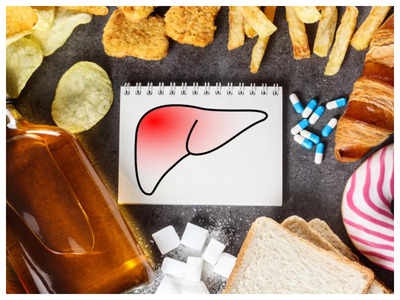Trending
This story is from August 2, 2022
Heal with foods: How eating right can manage fatty liver
Did you know that the top reason for a fatty liver is a poor diet!!! A diet that is rich in sugar, liquid, and industrial fats, and refined carbohydrates.

Did you know that you can get a fatty liver even without drinking any alcohol?
Your liver performs 500+ vital metabolic functions every day that include removing toxins from the body’s blood supply, maintaining healthy blood sugar levels and producing bile.
Unlike liver infection like hepatitis, fatty liver may be completely asymptomatic, however, it still impacts your physiological and metabolic health drastically.
Do you feel fatigued most of the time?
Do you catch a cold or flu instantly?
Some or all of these symptoms could point to having a fatty liver!!
Your liver is the body’s chemical plant and inspection station. It performs the following functions:
• Excretion of bilirubin, cholesterol, hormones, and drugs
• Bile production and excretion
• Metabolism of fats, proteins, and carbohydrates
• Storage of glycogen, vitamins, and minerals
• Synthesis of plasma proteins, such as albumin, and clotting factors
• Blood detoxification and purification

What is a fatty liver?
Non-Alcoholic Fatty Liver Disease (NAFLD) is the most common cause of chronic liver disease worldwide. A fatty liver disease is characterised by the accumulation of fat in the liver of patients with no alcohol abuse.
Fatty liver is common in Western countries, and the prevalence of NAFLD has grown in the Asia-Pacific region given the Western lifestyle and increased incidence of obesity. In the early stages Fatty liver shows no symptoms. Progression of the condition produces symptoms like appetite loss, weight loss, weakness, abdominal pain, liver enlargement, and in severe cases can cause jaundice and liver cirrhosis leading up to liver failure.
A fatty liver condition driven by poor lifestyle is now a part of the Metabolic Syndrome that also includes other lifestyle disorders such as obesity, diabetes, hypertension, high cholesterol, hypothyroidism etc.
Also Read: Best foods and drinks for a healthy liver
NAFLD is linked to the following:
• Overweight or obesity
• Insulin resistance, in which your cells don't take up sugar in response to the hormone insulin
• High blood sugar (hyperglycemia), indicating prediabetes or type 2 diabetes
• High levels of fats, particularly triglycerides, in the blood
The underlying causes of a fatty liver are:

Eating an unhealthy diet
Did you know that the top reason for a fatty liver is a poor diet!!! A diet that is rich in sugar, liquid, and industrial fats, and refined carbohydrates. Sugary drinks and beverages are the biggest culprits followed by packaged fruit juices, energy drinks, sweetened breakfast cereals, fast food, store-brought dips and sauces, processed meat, ready-to-eat noodles, and instant meals, frozen snacks, dairy products, energy bars, bakery goods like cake, doughnut and cookies, street food and almost everything that you could order online.
Easy Tip: Eat less processed foods, shop for fresh and whole ingredients that are not produced in an industrial food plant, and prepare and cook more meals at home with lots of vegetables, herbs and spices.
Also Read: Have fatty liver? These 10 foods cleanse liver naturally
Excessive smoking and alcohol consumption
Smoking can severely damage your liver as all the toxic chemicals in smoke have to be broken down by the liver. Drinking too much alcohol or too fast can severely overload your liver cells. When that ice-cold beer reaches your liver, it produces a harmful enzyme called acetaldehyde, which can destroy liver cells and may even lead to permanent scarring.
Being overweight
Obesity is known to play a significant role in the development of a fatty liver. A healthy liver should contain a negligible amount of fat, If it consists of more than 5% fat, then it’s considered ‘fatty’ leading to myriad health concerns. The common contributing factor to obesity and fatty liver is insulin resistance which develops with excess abdominal fat tissue. When a person is insulin resistant, muscles, fat, and liver cells can’t respond properly to this hormone. As a result, insulin accumulates in the blood and increases fatty acids circulating in the bloodstream. These fat molecules enter and deposit in liver cells initiating NAFLD.
Improving Nutritional Intake and Exercising regularly has enormous potential in preventing and treating Fatty Liver Disease.
How do you diagnose a fatty liver?
Clinically a fatty liver can show up in
- Blood work as Liver function tests –If any of the liver enzymes is detected high or the bilirubin and protein levels are abnormal, they may point to a fatty liver.
- Imaging tests - A computed tomography or ultrasound scanning method may aid in identifying this liver problem. On CT scanning, the liver may appear less dense than it normally should, and on ultrasound imaging, the organ will appear brighter than normal, with fat layers depicted in a wave-like pattern.

How can you reverse your fatty liver disease to some extent?
Early-stage fatty liver disease may be completely reversible and preventable. The below changes in your lifestyle may help significantly
Weight loss: Losing some weight and restoring your visceral fat and percentage of body fat to normal levels is the number one thing you can do to reverse NAFLD. Weight loss also supports your liver by improving your blood glucose (sugar) levels, cholesterol levels, and blood pressure.
Eat liver-friendly food for fatty liver disease
The best diet for reversing fatty liver disease is one that includes a wide variety of nutritious foods and limits sugar, “junk food,” refined fats, and alcohol.
Also Read: Can Giloy Tea actually impact liver functioning? Our analysis and the right recipe to prepare it
Here’s what this means:
• Eating lots of colourful vegetables such as cabbage, cauliflower, broccoli, eggplant, tomatoes, spinach, dark green vegetables, peppers, bitter guard, and sweet potato.
• Eat low fructose fruits such as berries, avocado, plum, peach, tangerine, pomegranate, and papaya. Avoid high fructose and sweet fruits.
• Replacing your wheat and rice with unpolished millets such as Ragi, Jowar, Buckwheat, Quinoa, Amaranth, Besan, Red rice, and Black rice, and get rid of White flour such as bread cookies and noodles.
• Eating nuts and seeds for snacks instead of store-bought crackers, chips or savoury mixes.
• Choosing healthier fats like cow ghee, coconut, and olive oil
• Completely cutting off simple sugars such as white sugar, processed honey, high fructose corn syrup, and artificial sweeteners.
• Mostly eating plants and reducing animal food substantially, especially animal foods that are processed such as ham, bacon, steak, sausages
Physical exercise
Doing at least 50 minutes of aerobic exercise 5 times per week with 15 mins of High-Intensity activity can help reverse NAFLD. It is also important to stay physically active throughout the day and break the sedentary pattern.
Fasting
Building any form of fasting from eating in a fixed window to eating one or two meals a day only to water fasting to fasting once a week can spare the liver in processing food and heal and regenerate liver tissue.
Top foods for liver health
1. Carrot, celery and spinach juice
This natural treatment is very effective for detoxing the liver. Blend carrot, celery, spinach with mint and herbs into a juice in a cold blender. You can drink this either an empty stomach or between your meals.

2. Indian gooseberry or amla
Amla has massive amounts of vitamin C which can help the liver to heal. Consume Amla raw or as a Chutney, boiled or pickled.
3. Dandelion tea
You can make the tea with powdered dandelion root or by boiling the roots and drinking the extract. Replace your Masala tea with Dandelion Tea.

4. Apple cider vinegar
Helps to purify your liver. If consumed before a meal, ACV can help metabolize fats quickly and also help in better nutrient absorption. You could consume Apple cider vinegar by mixing two teaspoons in a glass full of water and have it a few minutes before your meal.
5. Turmeric
Turmeric improves liver function. You can blend 1/2 tsp of turmeric and ¼ tsp of black pepper with ghee or coconut oil. Consume it on a daily basis.
6. Flax seeds, walnuts and avocados
Add flaxseeds, walnuts, and avocado to your diet plan as these foods will help protect the liver from disease. The glutathione in walnuts and avocados removes toxins transferred by your liver. Flax seeds have lignans that are fiber-like compounds that have antioxidant properties and reduce the toxic burden on the liver.

7. Green leafy vegetables and berries
Leafy vegetables improve the circulation of bile and pectin contained in green leafy vegetables and berries helps get rid of toxins in the digestion system. This serves as protection for the liver.
8. Green tea
Green tea in the form of leaves has a high quantity of catechins that help the liver function efficiently. You could take 2-3 cups of tea each day to keep your liver healthy and disease free.
9. Papaya and pineapple
Papaya and pineapple contain plant enzymes and can effectively treat a fatty liver. They are also rich source of carotenoids and other antioxidants.
10. Drink fluoride-free water
Consume 10 -12 glasses of clean fluoride-free water in a day. Drinking enough water prevents constipation and reduces the burden on the liver by helping to flush waste from the body. Staying hydrated makes the blood thinner, ultimately making it easier for the liver to filter.
Contributed By: Manjari Chandra, Consultant Functional Nutrition and Nutritional Medicine, Manjari Wellness, Max Healthcare, Metabalance
Thumb and Embed Images Courtesy: istock
For scrumptious recipes, videos and exciting food news, subscribe to our free Daily and Weekly Newsletters.
Your liver performs 500+ vital metabolic functions every day that include removing toxins from the body’s blood supply, maintaining healthy blood sugar levels and producing bile.
Unlike liver infection like hepatitis, fatty liver may be completely asymptomatic, however, it still impacts your physiological and metabolic health drastically.
Do you feel fatigued most of the time?
Do you have occasional pimples and pigmentation?
Do you catch a cold or flu instantly?
Some or all of these symptoms could point to having a fatty liver!!
Your liver is the body’s chemical plant and inspection station. It performs the following functions:
• Excretion of bilirubin, cholesterol, hormones, and drugs
• Bile production and excretion
• Metabolism of fats, proteins, and carbohydrates
• Storage of glycogen, vitamins, and minerals
• Synthesis of plasma proteins, such as albumin, and clotting factors
• Blood detoxification and purification

What is a fatty liver?
Non-Alcoholic Fatty Liver Disease (NAFLD) is the most common cause of chronic liver disease worldwide. A fatty liver disease is characterised by the accumulation of fat in the liver of patients with no alcohol abuse.
Fatty liver is common in Western countries, and the prevalence of NAFLD has grown in the Asia-Pacific region given the Western lifestyle and increased incidence of obesity. In the early stages Fatty liver shows no symptoms. Progression of the condition produces symptoms like appetite loss, weight loss, weakness, abdominal pain, liver enlargement, and in severe cases can cause jaundice and liver cirrhosis leading up to liver failure.
A fatty liver condition driven by poor lifestyle is now a part of the Metabolic Syndrome that also includes other lifestyle disorders such as obesity, diabetes, hypertension, high cholesterol, hypothyroidism etc.
Also Read: Best foods and drinks for a healthy liver
NAFLD is linked to the following:
• Overweight or obesity
• Insulin resistance, in which your cells don't take up sugar in response to the hormone insulin
• High blood sugar (hyperglycemia), indicating prediabetes or type 2 diabetes
• High levels of fats, particularly triglycerides, in the blood
The underlying causes of a fatty liver are:

Eating an unhealthy diet
Did you know that the top reason for a fatty liver is a poor diet!!! A diet that is rich in sugar, liquid, and industrial fats, and refined carbohydrates. Sugary drinks and beverages are the biggest culprits followed by packaged fruit juices, energy drinks, sweetened breakfast cereals, fast food, store-brought dips and sauces, processed meat, ready-to-eat noodles, and instant meals, frozen snacks, dairy products, energy bars, bakery goods like cake, doughnut and cookies, street food and almost everything that you could order online.
Easy Tip: Eat less processed foods, shop for fresh and whole ingredients that are not produced in an industrial food plant, and prepare and cook more meals at home with lots of vegetables, herbs and spices.
Also Read: Have fatty liver? These 10 foods cleanse liver naturally
Excessive smoking and alcohol consumption
Smoking can severely damage your liver as all the toxic chemicals in smoke have to be broken down by the liver. Drinking too much alcohol or too fast can severely overload your liver cells. When that ice-cold beer reaches your liver, it produces a harmful enzyme called acetaldehyde, which can destroy liver cells and may even lead to permanent scarring.
Being overweight
Obesity is known to play a significant role in the development of a fatty liver. A healthy liver should contain a negligible amount of fat, If it consists of more than 5% fat, then it’s considered ‘fatty’ leading to myriad health concerns. The common contributing factor to obesity and fatty liver is insulin resistance which develops with excess abdominal fat tissue. When a person is insulin resistant, muscles, fat, and liver cells can’t respond properly to this hormone. As a result, insulin accumulates in the blood and increases fatty acids circulating in the bloodstream. These fat molecules enter and deposit in liver cells initiating NAFLD.
Improving Nutritional Intake and Exercising regularly has enormous potential in preventing and treating Fatty Liver Disease.
How do you diagnose a fatty liver?
Clinically a fatty liver can show up in
- Blood work as Liver function tests –If any of the liver enzymes is detected high or the bilirubin and protein levels are abnormal, they may point to a fatty liver.
- Imaging tests - A computed tomography or ultrasound scanning method may aid in identifying this liver problem. On CT scanning, the liver may appear less dense than it normally should, and on ultrasound imaging, the organ will appear brighter than normal, with fat layers depicted in a wave-like pattern.

How can you reverse your fatty liver disease to some extent?
Early-stage fatty liver disease may be completely reversible and preventable. The below changes in your lifestyle may help significantly
Weight loss: Losing some weight and restoring your visceral fat and percentage of body fat to normal levels is the number one thing you can do to reverse NAFLD. Weight loss also supports your liver by improving your blood glucose (sugar) levels, cholesterol levels, and blood pressure.
Eat liver-friendly food for fatty liver disease
The best diet for reversing fatty liver disease is one that includes a wide variety of nutritious foods and limits sugar, “junk food,” refined fats, and alcohol.
Also Read: Can Giloy Tea actually impact liver functioning? Our analysis and the right recipe to prepare it
Here’s what this means:
• Eating lots of colourful vegetables such as cabbage, cauliflower, broccoli, eggplant, tomatoes, spinach, dark green vegetables, peppers, bitter guard, and sweet potato.
• Eat low fructose fruits such as berries, avocado, plum, peach, tangerine, pomegranate, and papaya. Avoid high fructose and sweet fruits.
• Replacing your wheat and rice with unpolished millets such as Ragi, Jowar, Buckwheat, Quinoa, Amaranth, Besan, Red rice, and Black rice, and get rid of White flour such as bread cookies and noodles.
• Eating nuts and seeds for snacks instead of store-bought crackers, chips or savoury mixes.
• Choosing healthier fats like cow ghee, coconut, and olive oil
• Completely cutting off simple sugars such as white sugar, processed honey, high fructose corn syrup, and artificial sweeteners.
• Mostly eating plants and reducing animal food substantially, especially animal foods that are processed such as ham, bacon, steak, sausages
Physical exercise
Doing at least 50 minutes of aerobic exercise 5 times per week with 15 mins of High-Intensity activity can help reverse NAFLD. It is also important to stay physically active throughout the day and break the sedentary pattern.
Fasting
Building any form of fasting from eating in a fixed window to eating one or two meals a day only to water fasting to fasting once a week can spare the liver in processing food and heal and regenerate liver tissue.
Top foods for liver health
1. Carrot, celery and spinach juice
This natural treatment is very effective for detoxing the liver. Blend carrot, celery, spinach with mint and herbs into a juice in a cold blender. You can drink this either an empty stomach or between your meals.

2. Indian gooseberry or amla
Amla has massive amounts of vitamin C which can help the liver to heal. Consume Amla raw or as a Chutney, boiled or pickled.
3. Dandelion tea
You can make the tea with powdered dandelion root or by boiling the roots and drinking the extract. Replace your Masala tea with Dandelion Tea.

4. Apple cider vinegar
Helps to purify your liver. If consumed before a meal, ACV can help metabolize fats quickly and also help in better nutrient absorption. You could consume Apple cider vinegar by mixing two teaspoons in a glass full of water and have it a few minutes before your meal.
5. Turmeric
Turmeric improves liver function. You can blend 1/2 tsp of turmeric and ¼ tsp of black pepper with ghee or coconut oil. Consume it on a daily basis.
6. Flax seeds, walnuts and avocados
Add flaxseeds, walnuts, and avocado to your diet plan as these foods will help protect the liver from disease. The glutathione in walnuts and avocados removes toxins transferred by your liver. Flax seeds have lignans that are fiber-like compounds that have antioxidant properties and reduce the toxic burden on the liver.

7. Green leafy vegetables and berries
Leafy vegetables improve the circulation of bile and pectin contained in green leafy vegetables and berries helps get rid of toxins in the digestion system. This serves as protection for the liver.
8. Green tea
Green tea in the form of leaves has a high quantity of catechins that help the liver function efficiently. You could take 2-3 cups of tea each day to keep your liver healthy and disease free.
9. Papaya and pineapple
Papaya and pineapple contain plant enzymes and can effectively treat a fatty liver. They are also rich source of carotenoids and other antioxidants.
10. Drink fluoride-free water
Consume 10 -12 glasses of clean fluoride-free water in a day. Drinking enough water prevents constipation and reduces the burden on the liver by helping to flush waste from the body. Staying hydrated makes the blood thinner, ultimately making it easier for the liver to filter.
Contributed By: Manjari Chandra, Consultant Functional Nutrition and Nutritional Medicine, Manjari Wellness, Max Healthcare, Metabalance
Thumb and Embed Images Courtesy: istock
For scrumptious recipes, videos and exciting food news, subscribe to our free Daily and Weekly Newsletters.
End of Article
FOLLOW US ON SOCIAL MEDIA








